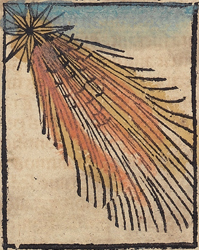Astronomy:Comet of 1472
The comet of 1472 was visible from Christmas Day 1471 to 1 March 1472 (Julian Calendar), for a total of 59 days.[1]
The comet is notable because it was observed by 15th-century astronomers, during a time of rapid progress in planetary theory, shortly before the Copernican Revolution. The comet was observed by Regiomontanus and Bernhard Walther from Nuremberg. Regiomontanus tried to estimate its distance from Earth, using the parallax. According to Seargeant (2009):[2]
In agreement with the prevailing Aristotelian theory on comets as atmospheric phenomena, he estimated its distance to be at least 8,200 miles (13,120 km) and, from this, estimated the central condensation as 26, and the entire coma as 81 miles (41.6 and 129.6 km respectively) in diameter. These values, of course, fail by orders of magnitude, but he is to be commended for this attempt at determining the physical dimensions of the comet.
An Italian physician named Angelo Cato de Supino also left a description of the comet, claiming it was as bright as the full moon, its tail extending over more than 30 degrees.[citation needed] The comet (or "broom star") was also observed in Chinese astronomy, where it is noted that it was visible even at midday.[citation needed] The 15th century English Chronicler, Warkworth, left a detailed account of the comet's appearance and disappearance from the night sky of England.
See also
References
- ↑ Donald K. Yeomans, Jet Propulsion Laboratory: Great Comets in History, 2007.
- ↑ David A. Seargeant. The Greatest Comets in History, 2009, p. 104
- Jane L. Jervis, Cometary Theory in Fifteenth-Century Europe (1985), 112ff.
- M. Celoria, "Comet of 1472", Nature, Vol. 316, NO.6024/JUL11 (1985), p. 107. doi:10.1038/316107b0
- J. O. Halliwell, "On a very particular and curious Account of the Comet of 1472, from a contemporary MS. Chronicle in Peterhouse Library", The London and Edinburgh Philosophical Magazine and Journal of Science vol. 14 (1839), 260f.
- J. O. Halliwell-Phillipps, "A chronicle of the first thirteen years of the reign of King Edward the Fourth by Warkworth, John, d. 1500"; University of Cambridge. Peterhouse. Library. Mss (230), [1]


